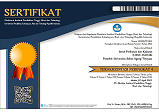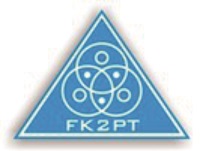Sosio-Ecological Dynamic of Small Scale Fisheries in Prigi Trenggalek
Abstract
Small scale fishing is a very important part of the fisheries sector. Not only play an important role in enhancing food security, but also becomes an absorbent for workers without the need for educational. Actors in the small-scale fishery, as defined by Law 45 of 2009, are fishermen who fish their daily needs with the largest size of 5 (five) Gross Register Tonnes (GT) of fishing boats. The fishermen of Prigi are dominated by small fishermen, where the fleet is no larger than 5 GT. The number of small-scale fishing gear in Prigi exceeds 60% of the total gear. The dominance of small-scale fisheries promotes good management with long-term goals, namely the sustainability of fisheries. Today's management of fisheries management has shifted from conventional management to community-based management. In order to support the community-based management of fisheries management, various information about the community, which is the policy objective, is needed. To this end, small-scale fisheries research in Prigi and strategies for the adaptation of the extended fishery fisheries were carried out. The method used is the snowball sampling method and the calculation of the diversity of catching resources. Fishermen who are the subject of the research are small-scale fishermen who operate ships under 5 GT. The gear is stretch fishing, gillnets and tonda fishing rods. There are small fishermen in Prigi who have different types of gear that are used at that time depending on the season of the fish. The selection of fishing gear by fishermen is likely to be caused by different expertise, skills and experience of fishermen in the operation of fishing gears. In addition, the capital held by fishermen to produce fishing gear and the economic level of the fish caught will also likely affect the fishers in choosing the type of fishing gear used each day. The adaptation strategies of fishermen to unpredictable catches are divided into two groups, namely the catch strategy and the search for alternative sources of income.
Keywords
Full Text:
PDFReferences
Allison EH, Perry AL, Badjeck MC, Neil Adger W, Brown K, Conway D, Dulvy NK. 2009. Vulnerability of national economies to the impacts of climate change on fisheries. Fish and Fisheries 10(2): 173-196.
Akbarsyah N, Wiyono ES, Solihin I. 2017. Tingkat Ketergantungan Dan Persepsi Nelayan Pancing Ulur Terhadap Sumberdaya Ikan di Prigi Trenggalek Jawa Timur. Marine Fisheries 8(2): 199-210.
Arkham, M.N., L. Adrianto, dan Y. Wardianto. 2015. Konektivitas Sistem Sosial – Ekologi Lamun dan Perikanan Skala Kecil di Desa Malang Rapat dan Desa Berakit, Kabupaten Bintan, Kepulauan Riau. Jurnal Ilmu dan Teknologi Kelautan Tropis 7(2): 433-451.
Battaglia, P., Romeo, T., Consoli, P., Scotti, G., & Andaloro, F. 2010. Characterizationof the artisanal fishery and its socio-economic aspects in the central Mediterranean Sea (Aeolian Islands, Italy). Fisheries Research 102(1): 87-97.
Badrudin. 2013. Analisis Data Catch & Effort untuk Pendugaan MSY [Makalah]. Indonesian Marine and Climate Support (IMACS) Project. Kerjasama USAID dengan Kementerian Kelautan dan Perikanan.
Hermawan M. 2006. Keberlanjutan Perikanan Tangkap Skala Kecil (Kasus Perikanan Pantai di Serang dan Tegal). [Disertasi]. Bogor: Sekolah Pascasarjana, Institut Pertanian Bogor.
Johnson AE, Cinner JE, Hardt MJ, Jacquet J, McClanahan TR, Sanchirico JN. 2013. Trends, current understanding and future research priorities for artisanal coral reef fisheries research. Fish and Fisheries 14(3): 281-292.
Kusumo RAB, Charinna A, Mukti GW. 2013. Analisis Gender dalam Kehidupan Keluarga Nelayan di Kecamatan Pangandaran Kabupaten Ciamis. Jurnal Social Economic of Agriculture. 2(1): 42-53.
Nasution R. 2003. Teknik Sampling. Medan: Fakultas Kesehatan Masyarakat Universitas Sumatera Utara.
Nazmar. 2013. Model Pemberdayaan Ekonomi Rumah Tangga Nelayan Skala Kecil Dengan Pengembangan Off-Fishing di Kota Padang. Jurnal Ekonomi. Manajemen dan Akuntansi I. 18(1).
Neuman WL. 2003. Social Research Methods, Qualitative and Quantitative Approaches. Fifth Edition. Boston: Pearson Education.
Nurdiani N. 2014. Teknik Sampling Snowball Dalam Penelitian Lapangan. ComTech 5(2): 1110-1118.
PPN Prigi. 2015. Laporan Statistik Pelabuhan Perikanan Nusantara (PPN) Prigi tahun 2009-2013. Trenggalek: Pelabuhan Perikanan Nusantara Prigi (PPN) Prigi.
Robinson OC. 2014. Sampling in interview-based qualitative research: A theoretical and practical guide. Qualitative Research in Psychology 11(1): 25-41.
Shigueto JA, Jeffrey CM, Mariela P, Peter HD, Jeffrey AS, Brendan JG. 2010. Where small can have a large impact: Structure and characterization of small-scale fisheries in Peru. Fisheries Research 106(2010): 8–17.
Wiyono E.S. 2010. Komposisi, diversitas dan produktivitas sumberdaya ikan dasar di perairan pantai Cirebon, Jawa Barat. Ilmu Kelautan 15(4): 214-220.
DOI: http://dx.doi.org/10.33512/jpk.v8i2.6727
Refbacks
- There are currently no refbacks.



_-_Copy1.png)